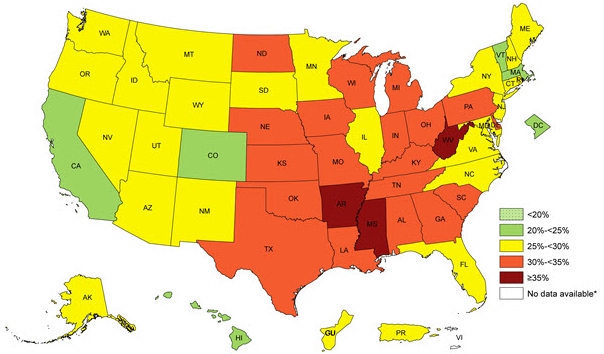A new class of anti-obesity compounds with potential anti-diabetic properties
September 24, 2015

Prevalence of Self-Reported Obesity Among U.S. Adults by State and Territory, BRFSS, 2014 (credit: Behavorial Risk Factor Surveillance System/CDC)
A molecule known as MnTBAP* has rapidly reversed obesity in mice and could be effective for humans in the future, according to researchers from Skidmore College and the Perelman School of Medicine at the University of Pennsylvania.
“In the span of a month, mice with pre-existing obesity lost 20 percent of their body weight and about 50 percent of their fat mass,” said Thomas H. Reynolds, PhD., an associate professor of Health and Exercise Sciences at Skidmore College. The weight loss is explained partly by a decrease in food consumption, but other mechanisms are also at play, according to the study published Wednesday (Sept. 23, 2015) in an open-access paper in PLOS One.
The authors report that MnTBAP also has beneficial effects on type 2 diabetes by improving insulin action in muscle and fat. Insulin is the hormone that allows tissues to take up glucose. “In type 2 diabetics, insulin action is impaired, causing the pancreas to go into overdrive in an attempt to maintain normal blood glucose levels.
“Over time, the pancreas becomes exhausted and can’t keep up, leading to rising blood glucose levels and the development of diabetes,” Jonathan Brestoff, the study’s first author, said in an exclusive interview with KurzweilAI. Brestoff is now at the Perelman School of Medicine at the University of Pennsylvania.
He said this molecule represents “a new class of anti-obesity compounds with potential anti-diabetic properties.” He has co-founded the biotech company Symmetry Therapeutics, Inc. to translate the team’s science into clinical applications to treat obesity via an anti-obesity compound called SYM401.
Symmetry is taking an unusual approach with its drug development by crowdfunding part of its research on the platform IndieGoGo. Brestoff said their efforts have gained international attention for attempting to add transparency to an otherwise secretive industry, and have attracted donations and private investors. Their campaign ends October 6, 2015.
On Monday Sept. 21, the CDC published new statistics on obesity in the United States indicating that it remains one of the biggest public health problems facing this country.
* Also known as Manganese [III] 5,10,15,20-tetrakis benzoic acid porphyrin.
Abstract of Manganese [III] Tetrakis [5,10,15,20]-Benzoic Acid Porphyrin Reduces Adiposity and Improves Insulin Action in Mice with Pre-Existing Obesity
The superoxide dismutase mimetic manganese [III] tetrakis [5,10,15,20]-benzoic acid porphyrin (MnTBAP) is a potent antioxidant compound that has been shown to limit weight gain during short-term high fat feeding without preventing insulin resistance. However, whether MnTBAP has therapeutic potential to treat pre-existing obesity and insulin resistance remains unknown. To investigate this, mice were treated with MnTBAP or vehicle during the last five weeks of a 24-week high fat diet (HFD) regimen. MnTBAP treatment significantly decreased body weight and reduced white adipose tissue (WAT) mass in mice fed a HFD and a low fat diet (LFD). The reduction in adiposity was associated with decreased caloric intake without significantly altering energy expenditure, indicating that MnTBAP decreases adiposity in part by modulating energy balance. MnTBAP treatment also improved insulin action in HFD-fed mice, a physiologic response that was associated with increased protein kinase B (PKB) phosphorylation and expression in muscle and WAT. Since MnTBAP is a metalloporphyrin molecule, we hypothesized that its ability to promote weight loss and improve insulin sensitivity was regulated by heme oxygenase-1 (HO-1), in a similar fashion as cobalt protoporphyrins. Despite MnTBAP treatment increasing HO-1 expression, administration of the potent HO-1 inhibitor tin mesoporphyrin (SnMP) did not block the ability of MnTBAP to alter caloric intake, adiposity, or insulin action, suggesting that MnTBAP influences these metabolic processes independent of HO-1. These data demonstrate that MnTBAP can ameliorate pre-existing obesity and improve insulin action by reducing caloric intake and increasing PKB phosphorylation and expression.